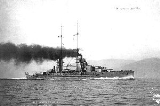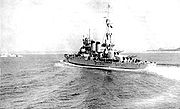
Italian battleship Conte di Cavour
Encyclopedia
Conte di Cavour was an Conte di Cavour class
Conte di Cavour class battleship
The Conte di Cavour class was a battleship class of the Regia Marina in World War I and World War II.-Design:This class was the second group of dreadnoughts in the Regia Marina. The ships were designed by Admiral Edoardo Masdea....
battleship
Battleship
A battleship is a large armored warship with a main battery consisting of heavy caliber guns. Battleships were larger, better armed and armored than cruisers and destroyers. As the largest armed ships in a fleet, battleships were used to attain command of the sea and represented the apex of a...
, that served in the Regia Marina
Regia Marina
The Regia Marina dates from the proclamation of the Kingdom of Italy in 1861 after Italian unification...
during World War I
World War I
World War I , which was predominantly called the World War or the Great War from its occurrence until 1939, and the First World War or World War I thereafter, was a major war centred in Europe that began on 28 July 1914 and lasted until 11 November 1918...
and World War II
World War II
World War II, or the Second World War , was a global conflict lasting from 1939 to 1945, involving most of the world's nations—including all of the great powers—eventually forming two opposing military alliances: the Allies and the Axis...
. It was named after the Italian statesman Count Camillo Benso di Cavour.
Construction and first years
Built to a design by Chief Engineer (Tenente Generale del Genio Navale) Edoardo Masdea, Conte di Cavour was based in TarantoTaranto
Taranto is a coastal city in Apulia, Southern Italy. It is the capital of the Province of Taranto and is an important commercial port as well as the main Italian naval base....
, in the impending war against Austria-Hungary
Austria-Hungary
Austria-Hungary , more formally known as the Kingdoms and Lands Represented in the Imperial Council and the Lands of the Holy Hungarian Crown of Saint Stephen, was a constitutional monarchic union between the crowns of the Austrian Empire and the Kingdom of Hungary in...
(World War I
World War I
World War I , which was predominantly called the World War or the Great War from its occurrence until 1939, and the First World War or World War I thereafter, was a major war centred in Europe that began on 28 July 1914 and lasted until 11 November 1918...
). At the beginning of the war, 24 May 1915, Conte di Cavour became the flagship
Flagship
A flagship is a vessel used by the commanding officer of a group of naval ships, reflecting the custom of its commander, characteristically a flag officer, flying a distinguishing flag...
of the Rear-Admiral Luigi Amedeo di Savoia
Luigi Amedeo, Duke of the Abruzzi
Prince Luigi Amedeo Giuseppe Maria Ferdinando Francesco di Savoia-Aosta , Duke of the Abruzzi , was an Italian nobleman, mountaineer and explorer of the royal House of Savoy...
. During the war, the battleship had no active missions, since it was impossible to engage the enemy: it performed 966 hours of training exercises compared to 40 hours spent in 3 war actions.
After the war, Conte di Cavour had a propaganda cruise in North America, entering the ports of Gibraltar, Ponta Delgada, Fayal, Halifax, Boston, Newport, Tompkinsville, New York, Philadelphia, Annapolis, and Hampton Roads.
In the summer of 1922, King Victor Emmanuel III
Victor Emmanuel III of Italy
Victor Emmanuel III was a member of the House of Savoy and King of Italy . In addition, he claimed the crowns of Ethiopia and Albania and claimed the titles Emperor of Ethiopia and King of Albania , which were unrecognised by the Great Powers...
travelled on Conte di Cavour to pay visit to the freed Italian cities in the Adriatic sea
Adriatic Sea
The Adriatic Sea is a body of water separating the Italian Peninsula from the Balkan peninsula, and the system of the Apennine Mountains from that of the Dinaric Alps and adjacent ranges...
. It was also used by Benito Mussolini
Benito Mussolini
Benito Amilcare Andrea Mussolini was an Italian politician who led the National Fascist Party and is credited with being one of the key figures in the creation of Fascism....
to travel to Tripoli
Tripoli
Tripoli is the capital and largest city in Libya. It is also known as Western Tripoli , to distinguish it from Tripoli, Lebanon. It is affectionately called The Mermaid of the Mediterranean , describing its turquoise waters and its whitewashed buildings. Tripoli is a Greek name that means "Three...
, in April 1925.
On 12 May 1928, in Taranto, it was disarmed; five years later, in October 1933, Conte di Cavour was transferred to Trieste
Trieste
Trieste is a city and seaport in northeastern Italy. It is situated towards the end of a narrow strip of land lying between the Adriatic Sea and Italy's border with Slovenia, which lies almost immediately south and east of the city...
, to be re-constructed.
Reconstruction and World War II

Conte di Cavour was returned to the Regia Marina on 1 June 1937; it was in Taranto at the beginning of the World War II
World War II
World War II, or the Second World War , was a global conflict lasting from 1939 to 1945, involving most of the world's nations—including all of the great powers—eventually forming two opposing military alliances: the Allies and the Axis...
, on 10 June 1940.
On 9 July 1940 it participated in the battle of Calabria
Battle of Calabria
The Battle of Calabria, was a naval battle during the Battle of the Mediterranean in World War II. It was fought between the Italian Royal Navy and the British Royal Navy and the Royal Australian Navy. The battle occurred 30 miles to the east of Punta Stilo, the "toe" of Italy , on 9 July 1940...
, which was the first between Italian and British navies. During the Night of Taranto, 11 November–12 November 1940, Conte di Cavour was sunk in shallow waters by a torpedo dropped by a British aircraft during the attack on the naval base of Taranto. The ship was raised at the end of 1941, and then sent to Trieste to be repaired and upgraded in the anti-aircraft armament, but it never returned to active duty.
On 10 September 1943, Conte di Cavour was captured by Germans, but later abandoned during Trieste bombing (15 February 1945). The battleship was scrapped on 27 February 1947.

